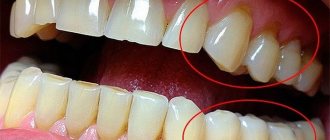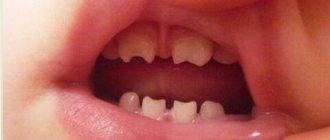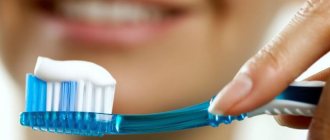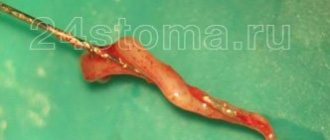Filling is a complex of dental procedures, including the removal of tooth tissue destroyed by caries, disinfection and treatment of the resulting cavity with adhesive preparations, placement and grinding of a dental filling.
Normally, after performing the above procedures, the patient should not experience discomfort or pain. For this reason, the appearance of any unpleasant sensations in the area of a filled tooth is an absolute reason for a return visit to the dental office.
Causes of tooth pain after filling
Pulpitis
The appearance of acute, spontaneous pain that grows and intensifies at night in a filled tooth may be due to the development of chronic or acute pulpitis. If such symptoms are detected, it is necessary to contact a dentist as soon as possible to remove a previously placed filling, remove the inflamed pulp, fill the root canals and the carious cavity itself.
Development of secondary caries
The source of pain in the tooth after filling can also be secondary caries, which gradually develops under the filling. The most common causes of this pathology are:
Causes of secondary caries
- insufficient disinfection of the carious surface before placing a filling;
- displacement of the installed filling under the influence of external factors;
- shrinkage of the filling material, which contributes to the formation of gaps between the filling and dental tissues;
- injury resulting in damage to the filling;
- irregular oral hygiene;
- violation of filling technology.
Treatment of secondary caries
When a secondary caries process is detected, the dentist removes the previously placed filling, cleans the resulting cavity from destroyed tissue, disinfects it and re-fills the tooth.
Underdrying or overdrying of the cavity
The causes of spontaneous pain that increases with biting in a treated tooth may be under-drying or over-drying of the tissues before filling. Before applying adhesive preparations, the surface dental tissues must be dried to a “wet sand” state (that is, the surface must remain wet, but there cannot be drops of water on it).
Consequences of overdrying tissues
Overdrying of dental tissues leads to damage to the nerve endings located in the surface layers of dentin. In turn, the death of nerve fibers can cause inflammatory damage to the pulp and other serious complications. Mild pain caused by overdrying of the carious cavity most often goes away on its own within 5-13 days. In situations where pain intensifies or persists for two weeks, patients are advised to return to the dental clinic for help.
Consequences of not drying the cavity
Failure to dry out the treated carious cavity can also cause pain. Drops of moisture prevent the penetration of adhesive preparations into the dentinal tubules, therefore, when the filling material shrinks, the composite easily comes off from the cavity floor, thereby forming pathological sinuses in the dental tissues. The only way out of this situation can be to replace the previously installed filling.
Granuloma or dental cyst
One of the likely causes of tooth pain after filling may be the formation of a granuloma (a localized area of inflamed tissue) or a root cyst (a pathological cavity in the gum tissue filled with bacteria, dead cells, blood and other physiological fluids). Granulomas and cysts are treated both conservatively (for example, using the depophoresis method) and through surgical intervention (cystectomy, hemisection, etc.).
Allergic reaction
In some cases, pain in a filled tooth can be the result of an allergic reaction to the components of the filling material. The clinical picture may be supplemented by urticaria, the appearance of an itchy rash and swelling on the patient’s skin and mucous membranes. If a patient is diagnosed with an allergy to the material used, the filling is immediately replaced.
Classification of the disease
Depending on the severity of the pathology, the following forms are distinguished:
- Streaked – characterized by the appearance of small stripes or streaks on the surface of the tooth. The upper jaw is most often affected by this form. The stripes are faint and cannot always be seen independently. Over time, they merge into one spot, in which strokes can also be distinguished.
- Spotted - this form is characterized by the presence of multiple chalky spots. They are well defined and located on the entire surface of the tooth. When drained, large spots form.
- A chalky-altered form - it is characterized by the presence of an affected light brown area, which turns into healthy enamel. This lesion is most often observed on the upper and lower incisors.
- Chalky-mottled - characterized by the presence of clear pigment spots. Sometimes there may be a variant of the presence of multiple dots on the enamel of a yellowish color. With this form, rapid thinning of the enamel is observed.
- Erosive - in addition to stains on the enamel, erosive defects occur. They contribute to the destruction of not only enamel, but also dentin.
- Destructive is the most severe form, in which the shape of the tooth crown is disrupted. This occurs due to thinning of the enamel and destruction of hard tooth tissue. The teeth themselves are quite fragile, prone to various damages (chips, breaks).
The disease can occur in mild, moderate and severe degrees. This depends on the number of teeth affected, as well as the depth of the pathological process. In severe cases, the patient experiences damage to more than 80% of the teeth. In this case, dentin is affected and crown deformation is observed. Fluorosis can also cause pathological disorders of skeletal bones.
Recommendations for eliminating the causes of pain in a filled tooth
If you experience discomfort or pain in a filled tooth, it is recommended:
- eliminate the load on the diseased tooth;
- seek professional dental care immediately;
- stop using traditional medicine.
Procedures related to filling replacement, removal of granulomas and cysts are performed on an outpatient basis and do not require much time.
At the same time, timely seeking dental care at a 24-hour dentistry allows you not only to get rid of unpleasant symptoms in the shortest possible time, but also to prevent the development of serious complications.
What are the causes of pathology
In accordance with generally accepted sanitary standards, the maximum concentration of fluorine compounds in water should not exceed 1.5 mg/l. But it should be remembered that fluoride also enters the body during breathing and through food. An excess of this microelement negatively affects tooth enamel and begins to destroy it. If you do not consult a doctor in time, bone tissue pathologies may develop - osteoporosis or osteosclerosis.
Important! The occurrence of the disease is associated with the individual characteristics of the body. Sometimes fluorosis develops at lower concentrations of fluoride.
Mainly permanent teeth are affected, in rare cases – milk teeth in children. This is due to the fact that the mineralization of the baby’s first teeth begins and ends during the period of intrauterine development. At this time, the placenta protects the child’s body from an excess of fluoride. But if a pregnant woman lives in an area where the content of fluoride compounds in the water greatly exceeds the norm, then the disease can also affect the child’s baby teeth.
Children aged 3–4 years are at risk if they have consumed water with a high content of fluoride compounds for 3 or more years. This disease is also diagnosed in adults who work in industries with high levels of fluoride in the air.
Dental fluorosis: treatment and prevention
Diagnosis is carried out at a dentist's appointment. Only a specialist will be able to distinguish the manifestations of fluorosis from a chalk spot, which is the initial stage of a carious lesion. An important distinguishing feature is that fluorous spots are multiple in nature and affect permanent teeth almost immediately after eruption. While initial caries in the spot stage is observed on single teeth.
Treatment is selected individually and depends on how severely damaged the enamel is. At the initial stage of the disease, it is recommended to conduct a course of professional whitening followed by strengthening the enamel using remineralization.
In this case, bleaching is carried out with a gentle composition based on inorganic acids. The number of procedures is selected by the doctor. Usually at least 10 sessions. During the whitening period, it is recommended to take calcium supplements. The result lasts for 6–8 months, then a second course of professional cleaning and bleaching is required.
The remineralization procedure helps strengthen the enamel structure, saturating it with minerals. Calcium and phosphorus compounds penetrate dentin and restore enamel from the inside. This procedure is carried out in several ways:
- Applications with a special composition.
- Electrophoresis or phonophoresis.
- Wearing mouth guards in which active gel is applied.
On average, at least 15 procedures are prescribed. Before the procedure, complete sanitation of the oral cavity is mandatory.
If the disease has already spread to the dentin, then simply bleaching will be ineffective. For moderate severity of fluorosis, methods of aesthetic tooth restoration are used:
- installation of ceramic veneers;
- restoration of tooth shape and color using crowns.
Such methods are recommended not only for aesthetic purposes, but also for medicinal purposes. They help stop further tooth decay and reduce enamel sensitivity.
Home care is also important - using fluoride-containing toothpastes, taking vitamin and mineral complexes, reducing the intake of fluoride from water and food.
How to prevent the disease from developing
The main preventive measure to combat fluorosis is to control the amount of fluoride in drinking water, as well as in the air. Such measures are especially important for areas where the amount of fluoride in the population’s water supply has been found to exceed the norms. Such events are held at the state level.
On an individual basis, it is recommended to use purchased purified water for drinking or use tap filters for additional purification. At the same time, it is important to engage in prevention from the moment the child is conceived. A pregnant woman should be especially careful when choosing food and drinking water. Additional intake of vitamins C, D, and calcium gluconate can reduce the risk of fluorosis several times, especially in children.
When a baby is born, it is recommended to feed him breast milk for as long as possible. After introducing complementary foods, use juices or dairy products instead of water, if possible. If you live permanently in an endemic area, you need to take your children to other areas every year for health improvement. Replacing the water source for 3-4 months helps strengthen tooth enamel and stop the development of the disease.
An important point in disease prevention is nutrition. Limit or completely eliminate products containing fluoride. These are sea fish, nuts, spinach, seaweed. You need to eat more fresh vegetables or fruits.
Also, after consulting a doctor, you can use medicinal remineralizing toothpastes or applications at home.
Prevention of purulent pulpitis
Purulent pulpitis is a rather insidious disease that can develop at any time and in almost every patient. To avoid its occurrence, you need to strictly monitor your oral hygiene, promptly consult a doctor and treat caries and other dental diseases.
It is necessary to visit a specialist even if the slightest symptoms appear in the form of a reaction to cold and hot, pain when biting or pulsation in the tooth.
It is also important to contact only qualified doctors who can provide a high-quality and professional filling. Remember: the better the filling, the longer the tooth will remain healthy.
We hope that the problem of pulpitis will never affect you, and all visits to dentists will be exclusively preventive. Professional toothpaste “ASEPTA PLUS REMINERALIZATION” will help strengthen your teeth and prevent the occurrence of caries and pulpitis.
This product increases the resistance of teeth to the formation of caries; high concentrations of hydroxyapatite and thermal mud help strengthen teeth and gums and reduce hypersensitivity.











